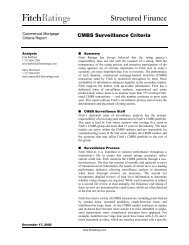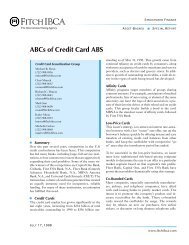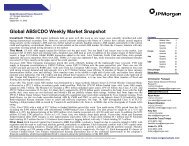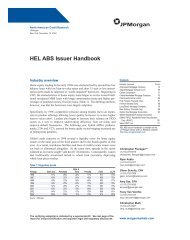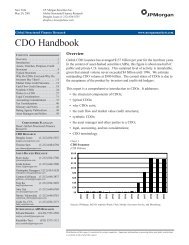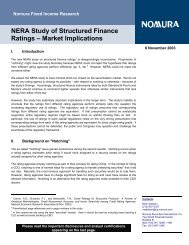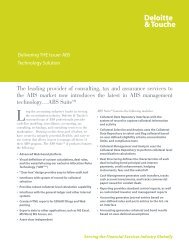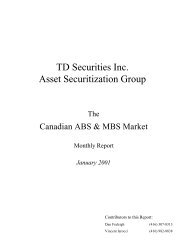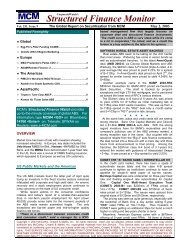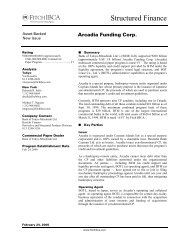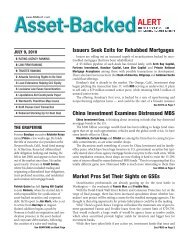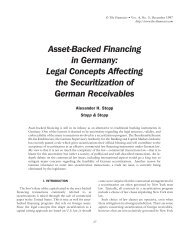Securitization Glossary - Securitization.Net
Securitization Glossary - Securitization.Net
Securitization Glossary - Securitization.Net
You also want an ePaper? Increase the reach of your titles
YUMPU automatically turns print PDFs into web optimized ePapers that Google loves.
Nomura Fixed Income Research<br />
For example, if an inverse floater uses LIBOR as its benchmark,<br />
increases in LIBOR will reduce the rate of interest on the<br />
security. In many cases, an inverse floater is created by<br />
subtracting the benchmark from a fixed rate (e.g., the inverse<br />
floater pays interest at a rate of 10%-LIBOR). Inverse floaters<br />
appear most frequently in CMOs.<br />
jumbo loan – a conventional loan that is too large to be<br />
purchased by Fannie Mae or Freddie Mac. Most of the time, the<br />
term jumbo loan refers to a loan that meets all applicable<br />
requirements of the Fannie Mae/Freddie Mac programs, except<br />
for size. In particular, the term jumbo loan rarely is used to refer<br />
to a subprime mortgage loan. MBS backed by jumbo loans<br />
usually use subordination as their primary means of credit<br />
enhancement. See glossary entries for "Fannie Mae" and "B&C<br />
borrowers."<br />
legal final maturity – in reference to a bond, the date before<br />
which the bond must be retired in order not to be in default. In<br />
the case of residential MBS, the legal final maturity is<br />
determined on the assumption that none of the underlying<br />
mortgage loans are prepaid. In the case of credit card ABS and<br />
certain other deals backed by revolving pools of assets, legal<br />
final maturity is determined on the assumption that poor asset<br />
performance causes the trust to enter early amortization at the<br />
latest possible time. A security's legal final maturity can occur<br />
no earlier than its expected maturity. See "expected maturity."<br />
loan-to-value ratio; LTV – a measure of the collateral coverage<br />
for a mortgage loan. In the case of a residential purchasemoney<br />
mortgage loan, the loan-to-value ratio is calculated as<br />
the ratio of (1) the amount of the loan to (2) the lesser of<br />
purchase price or the appraised value of the subject property.<br />
In the case of a residential refinancing loan, the loan-to-value<br />
ratio is calculated as the ratio of the loan amount to the<br />
appraised value of the subject property. A lower LTV reflects<br />
higher levels of collateral coverage – and presumably lower risk<br />
– for a loan.<br />
lockout – a form of protection against the risk that a borrower will<br />
prepay a mortgage loan. A lockout is a prohibition against<br />
prepayments. A lockout may be either temporary (i.e., it expires<br />
after a specified period) or permanent (i.e., lasting for the entire<br />
term of a loan). Lockouts are a feature of some commercial<br />
mortgage loans but seldom appear in residential mortgage<br />
loans.<br />
manufactured home; manufactured housing – a low-cost,<br />
factory build home, which is shipped to its installation site on a<br />
truck. A manufactured home generally is a single-floor structure<br />
installed on a concrete slab. Sometimes, two manufactured<br />
housing units are installed side-by-side to create a so-called<br />
"double wide" home. Manufactured homes are often<br />
recognizable by their simple architectural form (rectangular<br />
shape) and single-story design. Manufactured homes are most<br />
common in the southern U.S., where their modest insulation is<br />
sufficient to handle the climate. Regular homes differ from<br />
manufactured homes in that the former are larger, more<br />
elaborate, more expensive, built on site, and often contain<br />
higher-quality materials. Manufactured homes are popular with<br />
two particular segments of the population: Low- and moderateincome<br />
homebuyers find manufactured homes attractive<br />
because of their low cost. Senior citizens like them because<br />
their single-story design (without a basement) means that there<br />
are no stairs in the home. Until the mid-1970s, manufactured<br />
クとする 場 合 、LIBOR が 上 昇 すると 逆 変 動 利 付 債 の 金 利 は 低 下 す<br />
る。 多 くの 場 合 、 逆 変 動 利 付 債 の 金 利 は 一 定 の 固 定 金 利 からベンチ<br />
マークを 差 し 引 いたもの(10% - LIBOR など)と 設 定 される。 逆 変<br />
動 利 付 債 は CMO において 最 も 頻 繁 に 見 られる。<br />
ジャンボ・ローン - FHA/VA の 保 険 の 付 いていないコンベンショナ<br />
ル( 従 来 型 )ローンで、 融 資 額 がファニーメイとフレディマックの 基 準<br />
の 上 限 を 超 えるもの。 一 般 に、ジャンボ・ローンは、 融 資 額 以 外 のフ<br />
ァニーメイとフレディマックの 全 ての 基 準 を 満 たしているものを 指 すこ<br />
とが 多 く、サブプライム 層 のモーゲージを 指 すことはほとんどない。<br />
一 方 、ジャンボ・ローンのプールで 裏 付 けされた MBS は、 信 用 補 完<br />
の 手 段 としてサブオーディネーション 構 造 を 使 用 することが 多 い。「フ<br />
ァニーメイ」、「B&C 債 務 者 」の 欄 も 参 照 。<br />
法 定 最 終 償 還 期 日 - 債 券 において、デフォルトとみなされないため<br />
の 償 還 終 了 期 限 のこと。 住 宅 用 MBS では、 裏 付 けプールのモーゲ<br />
ージ・ローンが 全 く 期 限 前 返 済 されないと 想 定 して 法 定 最 終 償 還 期<br />
日 が 決 定 される。 一 方 、クレジットカード ABS などのリボルビング 債<br />
権 を 担 保 としたディールでは、 資 産 パフォーマンスが 悪 化 した 場 合 に<br />
トリガーされる 早 期 償 還 が 最 も 遅 く 発 生 した 場 合 を 想 定 して 法 定 最<br />
終 償 還 期 日 を 計 算 する。なお、 法 定 最 終 償 還 期 日 が 予 想 償 還 期 日<br />
以 前 にくることはない。<br />
担 保 掛 目 ; LTV レシオ - モーゲージ・ローンの 担 保 カバレッジを<br />
測 る 尺 度 。 住 宅 購 入 資 金 用 のモーゲージ・ローンの 場 合 、 担 保 掛 目<br />
は、(1) 融 資 額 と(2) 対 象 物 件 の 購 入 金 額 と 鑑 定 評 価 額 のどちらか<br />
小 さい 方 、の 比 率 として 計 算 する。 一 方 、 住 宅 用 の 借 換 ローンの 場<br />
合 は、 担 保 掛 目 は 融 資 額 と 対 象 物 件 の 鑑 定 評 価 額 の 比 率 として 計<br />
算 する。 担 保 掛 目 が 低 い 場 合 は、 担 保 カバレッジが 十 分 にあり、ロ<br />
ーンのが 低 リスクであることを 意 味 する。<br />
ロックアウト - 債 務 者 がモーゲージ・ローンを 早 期 返 済 するリスクに<br />
対 するプロテクションの 一 つ。ロックアウト 期 間 には 期 限 前 返 済 が 禁<br />
止 されるが、 一 定 期 間 後 に 失 効 する 場 合 と、 全 期 間 に 有 効 な 場 合 と<br />
がある。ロックアウトは 商 業 用 不 動 産 モーゲージにはしばしば 登 場<br />
するが、 住 宅 用 モーゲージではほとんど 見 られない。<br />
マニュファクチャード・ホーム; マニュファクチャード・ハウジング -<br />
工 場 で 生 産 され、トラックで 現 地 まで 運 ばれる 低 価 格 のプレハブ 住<br />
宅 のこと。 一 般 にマニュファクチャード・ホームとは、 平 屋 建 てでコン<br />
クリートの 床 板 に 設 置 される 形 式 のものを 指 す。また、2 個 のユニット<br />
を 隣 り 合 わせに 設 置 して「ダブルワイド」と 呼 ばれる 形 態 にする 場 合<br />
もある。マニュファクチャード・ホームは、 単 純 な 長 方 形 の 平 屋 建 てで<br />
あるのが 大 きな 特 徴 で、 気 候 が 穏 やかで 堅 固 な 建 築 構 造 を 必 要 とし<br />
ない 米 国 南 部 に 多 く 見 られる。 通 常 の 住 宅 とマニュファクチャード・ホ<br />
ームが 異 なるのは、 前 者 の 方 が 規 模 が 大 きく、 豪 華 かつ 高 価 であ<br />
り、より 高 級 な 建 築 材 を 使 って 現 地 で 建 設 される 点 である。マニュフ<br />
ァクチャード・ホームは、 廉 価 を 魅 力 に 感 じる 低 中 所 得 層 と、 地 下 室<br />
や 階 段 のない 平 屋 建 てを 好 む 高 齢 者 層 に 人 気 が 高 い。1970 年 代<br />
半 ばまで、マニュファクチャード・ホームは「モービル・ホーム」あるい<br />
は「トレーラー」と 呼 ばれていたが、こうした 呼 称 は 差 別 的 として 住 宅<br />
所 有 者 に 疎 まれ、 次 第 に 使 われなくなった。 一 方 、マニュファクチャ<br />
ード・ホームより 豪 華 かつ 高 価 な「モジュラー・ホーム」という 住 宅 形<br />
態 もあるが、これは 現 地 で 建 設 される 通 常 の 住 宅 の 一 種 とみなされ<br />
ており、マニュファクチャード・ホームには 含 まれない。<br />
(13)



